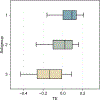SubgroupTE: Advancing Treatment Effect Estimation with Subgroup Identification
- PMID: 40575765
- PMCID: PMC12199269
- DOI: 10.1145/3718097
SubgroupTE: Advancing Treatment Effect Estimation with Subgroup Identification
Abstract
Precise estimation of treatment effects is crucial for accurately evaluating the intervention. While deep learning models have exhibited promising performance in learning counterfactual representations for treatment effect estimation (TEE), a major limitation in most of these models is that they often overlook the diversity of treatment effects across potential subgroups that have varying treatment effects and characteristics, treating the entire population as a homogeneous group. This limitation restricts the ability to precisely estimate treatment effects and provide targeted treatment recommendations. In this paper, we propose a novel treatment effect estimation model, named SubgroupTE, which incorporates subgroup identification in TEE. SubgroupTE identifies heterogeneous subgroups with different responses and more precisely estimates treatment effects by considering subgroup-specific treatment effects in the estimation process. In addition, we introduce an expectation-maximization (EM)-based training process that iteratively optimizes estimation and subgrouping networks to improve both estimation and subgroup identification. Comprehensive experiments on the synthetic and semi-synthetic datasets demonstrate the outstanding performance of SubgroupTE compared to the existing works for treatment effect estimation and subgrouping models. Additionally, a real-world study demonstrates the capabilities of SubgroupTE in enhancing targeted treatment recommendations for patients with opioid use disorder (OUD) by incorporating subgroup identification with treatment effect estimation.
Keywords: Deep learning; Opioid use disorder; Subgroup analysis; Treatment effect estimation.
Figures







Similar articles
-
Magnetic resonance perfusion for differentiating low-grade from high-grade gliomas at first presentation.Cochrane Database Syst Rev. 2018 Jan 22;1(1):CD011551. doi: 10.1002/14651858.CD011551.pub2. Cochrane Database Syst Rev. 2018. PMID: 29357120 Free PMC article.
-
Signs and symptoms to determine if a patient presenting in primary care or hospital outpatient settings has COVID-19.Cochrane Database Syst Rev. 2022 May 20;5(5):CD013665. doi: 10.1002/14651858.CD013665.pub3. Cochrane Database Syst Rev. 2022. PMID: 35593186 Free PMC article.
-
The use of Open Dialogue in Trauma Informed Care services for mental health consumers and their family networks: A scoping review.J Psychiatr Ment Health Nurs. 2024 Aug;31(4):681-698. doi: 10.1111/jpm.13023. Epub 2024 Jan 17. J Psychiatr Ment Health Nurs. 2024. PMID: 38230967
-
What is the value of routinely testing full blood count, electrolytes and urea, and pulmonary function tests before elective surgery in patients with no apparent clinical indication and in subgroups of patients with common comorbidities: a systematic review of the clinical and cost-effective literature.Health Technol Assess. 2012 Dec;16(50):i-xvi, 1-159. doi: 10.3310/hta16500. Health Technol Assess. 2012. PMID: 23302507 Free PMC article.
-
Behavioral interventions to reduce risk for sexual transmission of HIV among men who have sex with men.Cochrane Database Syst Rev. 2008 Jul 16;(3):CD001230. doi: 10.1002/14651858.CD001230.pub2. Cochrane Database Syst Rev. 2008. PMID: 18646068
References
-
- 2020. MarketScan Research Databases. https://www.ibm.com/products/marketscan-research-databases
-
- Alaa Ahmed M and Van Der Schaar Mihaela. 2017. Bayesian inference of individualized treatment effects using multi-task gaussian processes. Advances in neural information processing systems 30 (2017).
-
- Argaw Peniel N, Healey Elizabeth, and Kohane Isaac S. 2022. Identifying Heterogeneous Treatment Effects in Multiple Outcomes using Joint Confidence Intervals. In Machine Learning for Health. PMLR, 141–170.
-
- Arthur David and Vassilvitskii Sergei. 2007. K-means++ the advantages of careful seeding. In Proceedings of the eighteenth annual ACM-SIAM symposium on Discrete algorithms. 1027–1035.
Grants and funding
LinkOut - more resources
Full Text Sources
